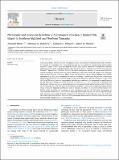| dcterms.abstract | Aeromonads disease outbreaks are now becoming a common phenomenon in freshwater farmed fish worldwide. In Tanzania, the aquaculture field is increasingly growing save to sustain food protein demand and strengthen household income. To avoid losses that tilapia fish farmers might account, information on magnitude of infection and characteristics of the aetiological agent is vital. This study aimed to establish the prevalence of aeromonads infection in farmed tilapia and assess pond and fish health management practices. A cross sectional study was carried out between February 2017 and October 2018 and a total of 816 whole fish samples were aseptically collected from 32 ponds in Ruvuma, Mbeya, Iringa and Kilimanjaro regions. During sampling, water quality parameters were taken and questionnaires to assess the knowledge of farmers were also provided. Isolation and identification of bacteria was conducted using conventional biotyping and molecular techniques. A total of 201 (80.4%) of 250 isolates that were conventionally identified were confirmed to be aeromonads by amplification of 820 bp rpoD gene, making the overall prevalence of 24.6% (201, n = 816). Sequencing of rpoD gene and phylogenetic analysis revealed two aeromonads species, Aeromonas hydrophila and Aeromonas veronii. To the best of our knowledge this is the first report to establish the prevalence of aeromonads in apparently healthy farmed tilapia in Southern highlands and Northern zone of Tanzania. In addition it was observed that farmers were lacking proper knowledge and awareness on pond management practices and fish health management. In conclusion, the infection rate of aeromonads in apparently health tilapia coupled with lack of proper knowledge and awareness on pond and fish health management by fish farmers in the study area poses risk of diseases outbreaks in their farms in future. Therefore, it is recommended that the farmers should be trained on basic pond and fish health management and control strategies. | |

